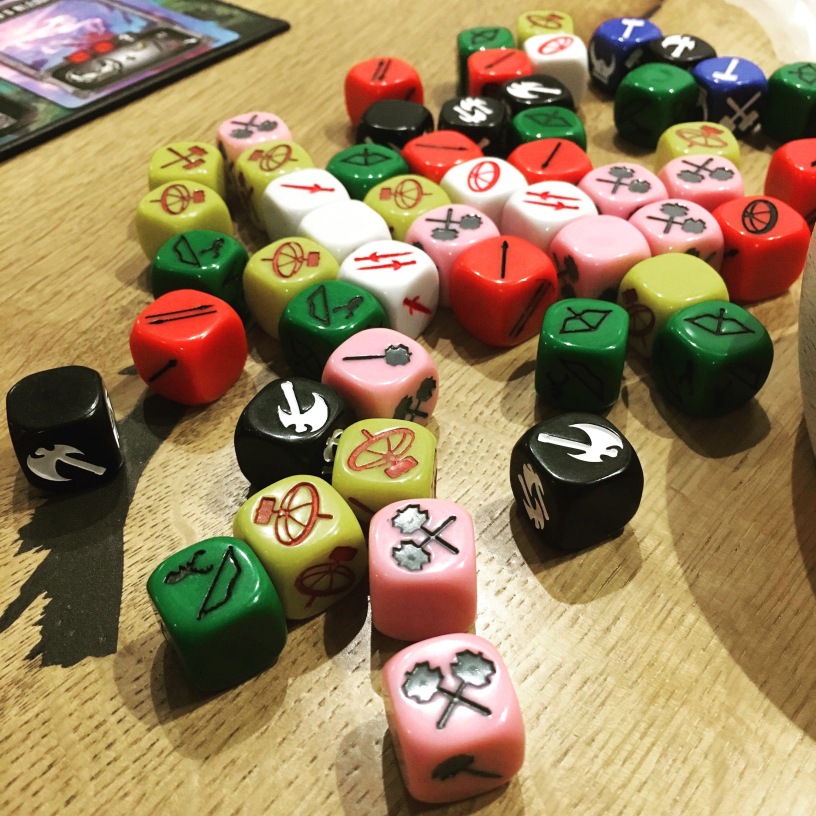Type: Worker Placement / Push your Luck
Time to play: 75-90 minutes (Teaching: 10 minutes)
Best played with: 3 Player (2 – 5 Players)
Dice! Dice! Dice! Or at least that should be the tagline of this game. This is a combination of dice based combat with worker placement in a really distinct game full of theme, tough choices and lots of paths to victory.
Now, before I get too far into this, I should say that I don’t normally talk about expansions to games, but I actually felt that the Valhalla expansion to this game made such a difference and such a big improvement that I would never play this game without it. I will try to explain why as I explain a bit of how the game works.
So, it’s a classic worker placement. It’s eight rounds of setting down your vikings and taking the action relating to that space. Typical worker placement options – build this, take food, take wood, draw an objective card…oh and fight some monsters. Key to theme, you are able to place a viking down to show where you will fight the monster. Like all good vikings, once you pick a fight – no one else can. Picking these spots therefore important as monsters are a key part of how you score points.
There are lots of different monsters, some with bonus rewards, some to pass blame (negative points) to other players, and some to just score victory points. Pick your monster during the round by putting your viking down and then at the end of the round you allocate dice to fight it.
This is where the worker placement mixes with the push your luck. During the round, or from the previous rounds, you will have picked up different coloured die. Each dice has different probabilities to hit, different probabilities to defend and some risk of a miss. Allocate the dice for each fight at the start of the turn (no warrior can fight two battles at once), and then be roll to see how combat goes.
You push your luck, because in each battle you can risk different numbers of dice, but to score the maximum points you will need to spread the die thinly between fights and risk losing. Each fight then, you roll the dice apply your hits and apply the hits from the enemy. If you both survive you roll again and apply the new results. Each enemy hit costs you a dice, whilst each of your hits takes a life point from the enemy. The enemies never weaken, never tire, but they cannot defend either. Multiple rounds of combat may take place to chip down the enemy and achieve the victory – losing viking warriors along the way.
This is where Valhalla steps in! If you are playing the standard game, you want to win and you want to have as many warriors survive as you can. Once you add Valhalla, you gain the rules for life after dice death. Once a warrior dies you get there token which can be spent in Valhalla for more points, more bonuses or indeed more warriors (who are stronger!). You start to want the dice to die in the combat – to lose some but not all. To lose warriors but not the fight. It becomes a much more complicated when you try to run a fight in which you win, but you lose warriors along the way – any one can overwhelm an enemy, but to win by a fraction is much harder.
Also, new dice from the Valhalla bring new stats / new probabilities. This is all made yet more complicated by the seas and mountains which could see your vikings fail before they reach their target (on the random draw of a card).
This is a lot of output luck then, and some players will be put off by this. However, I have never seen a better example of how this output luck brings about epic stories. The time when you needed to roll the final dice to kill the troll. The time when you lost a warrior to the seas only to win the fight, and the time when the great army failed to slay a simple troll. Great moments made from uncontrollable dice rolls. Balanced out by the fact that you role multiple times – where repetition provides balance.
The other thing to note is that this game is tight or cut-throat. There are strategies to be played to cut off your opponents move, block the set they are collecting (monster score bonus points in sets), or to stop them getting the free boat. This appeals to some, but other players will find this too brutal and almost “take that” in it’s approach.
Otherwise thought, this game offers many paths to victory, many exciting stories and lots of thematic elements. I can see why this game has proved popular but without a doubt this is enhanced by the Valhalla expansion and the way the game incentives lead you to take more risks, spreading your armies more thinly.
Last notes,
- If you like a mid-weight game with little downtime, check this out
- If you hate output luck – maybe just one too many dice
- If you win, try again and see with a new leader (and asymmetric power!)
